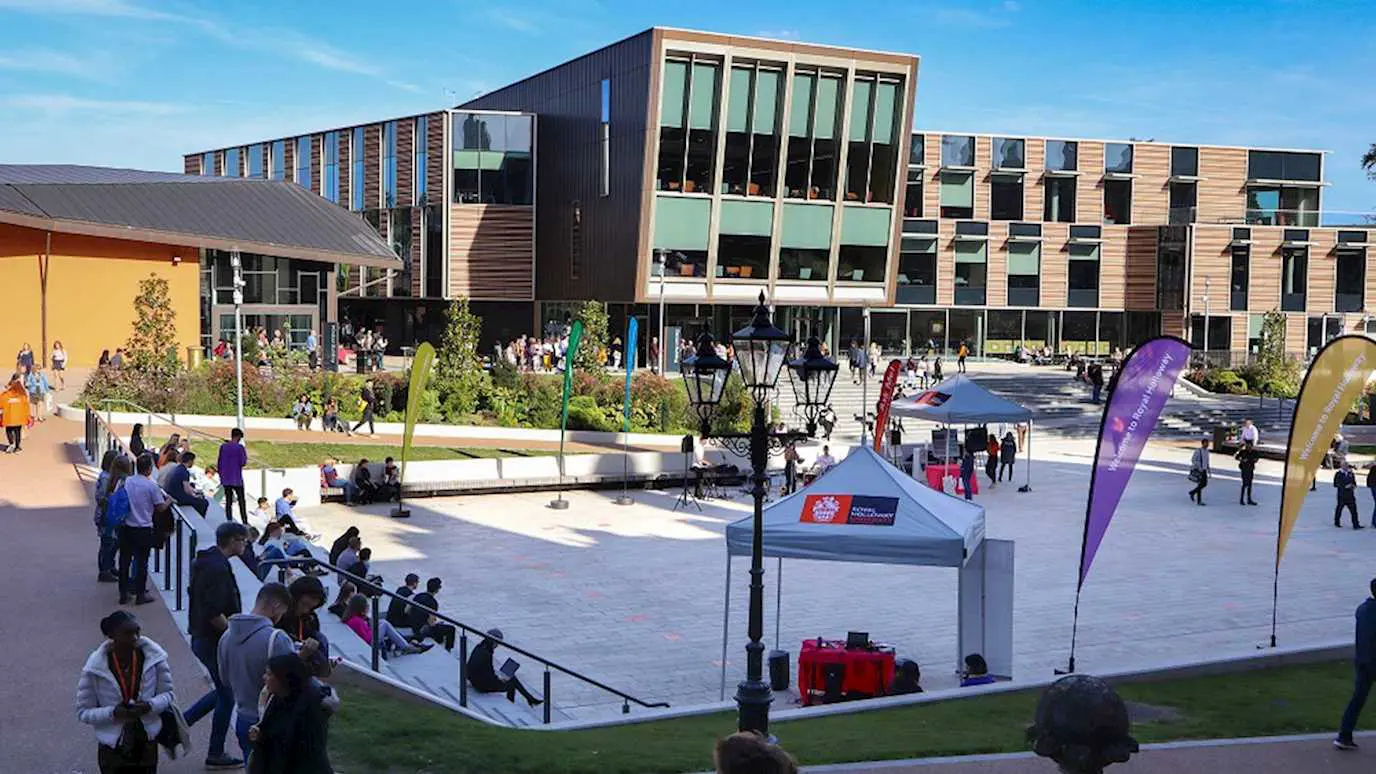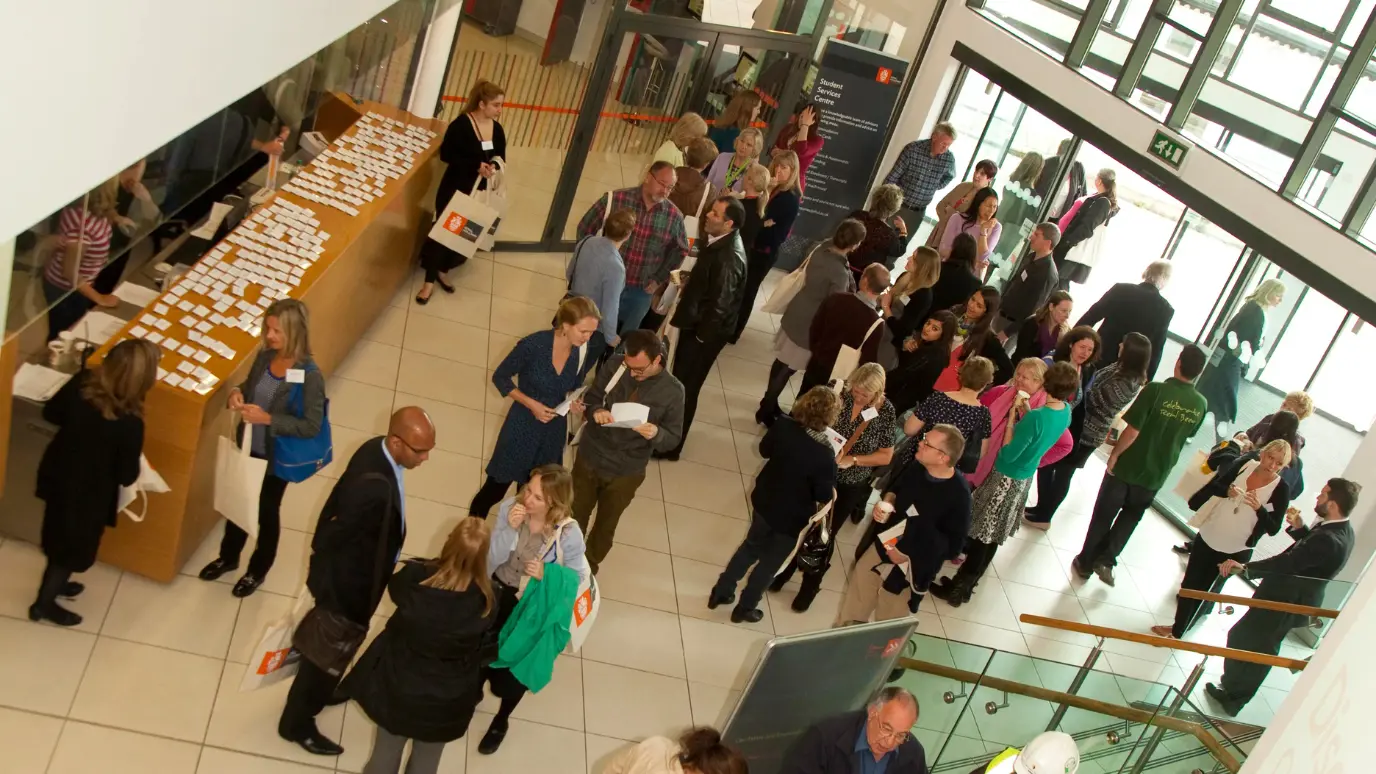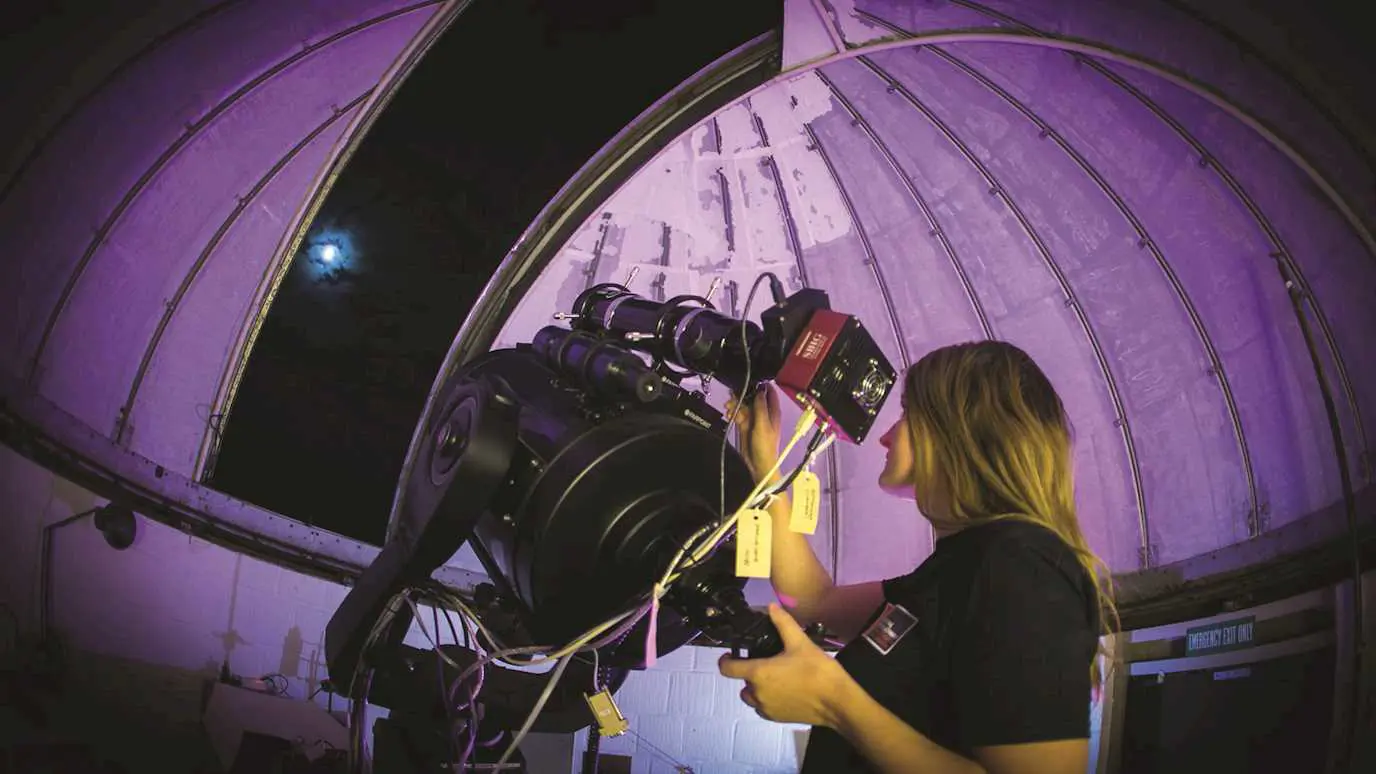Course options
Key information
Duration: 4 years full time
UCAS code: F303
Institution code: R72
Campus: Egham
The course
Physics MSci (MSci)
Our students often say their enthusiasm to study Physics stems from wanting to learn more about the Higgs particle, dark matter, nanotechnology or just a wide-ranging curiosity about how things really work. Whatever your reasons, our Physics department aims to inform and excite you in the study of Physics, the most fundamental of the sciences.
As one of the most respected centres for Physics teaching and research in the UK, you will join a vibrant environment, where you can pursue your studies and plan your future career.
On our four-year MSci course, we’ll cover the core material that a graduate physicist would be expected to know, including quantum mechanics, electromagnetism, statistical physics and thermodynamics, Einstein’s relativistic physics and the study of the fundamental structure of matter and the universe. You’ll also develop the mathematical, experimental and conceptual knowledge and skills to a more advanced level.
Your fourth year is intercollegiate, which means you can pick choices from other University of London colleges – modules can include Quantum Computation, Nanoscale Physics and others. You’ll also develop experimental, conceptual and observational skills from your final year Major Project, which will make you an attractive candidate in a range of sectors, including management and finance, as well as scientific, technical, engineering and teaching careers.
We’re based at the heart of the campus, where you’ll have access to laboratories, technical help, academic staff and, on the roof of the department, our astronomical dome. In Egham Surrey, we’re well away from the light pollution of the big city so our telescopes can give you the best observational astronomy in the University of London. Beyond the specialist equipment, we also have video-conferencing facilities that allow people to take part in seminars and lectures at other institutions.
- Research is expanding in new and exciting directions, plus strategic partnerships such as CERN and the National Physical Laboratory (NPL), SNOLAB and with industry, and there are impressive research facilities in the Physics labs with dedicated technical help.
- We put a real emphasis on small group teaching – a close-knit, friendly and supportive environment with high staff-student ratio and an open door policy.
- We enjoy a strong track record of high student satisfaction in the annual National Student Survey.
- We’ve been awarded IOP Juno Champion and Athena SWAN silver awards for best practice in equality, promoting women in science and welcoming large cohorts of female students
- This course is fully accredited by the Institute of Physics (IOP)
- A wide range of fourth-year options taught across the University of London physics consortium, providing access to world-leading experts.
- Extended research project embedded within a research group, working directly with your personal academic supervisor.
- Final year builds on the core physics content allowing you to gain specialist knowledge in your chosen area of interest.
From time to time, we make changes to our courses to improve the student and learning experience. If we make a significant change to your chosen course, we’ll let you know as soon as possible.
Course structure
Core Modules
Year 1
-
In this module you will develop an understanding of how to solve problems involving one variable (either real or complex) and differentiate and integrate simple functions. You will learn how to use vector algebra and geometry and how to use the common probability distributions.
-
In this module you will develop an understanding of how to solve problems involving more than one variable. You will learn how to use matrices and solves eigenvalue problems, and how to manipulate vector differential operators, including gradient, divergence and curl. You will also consider their physical significance and the theorems of Gauss and Stokes.
-
In this module you will develop an understanding of good practices in the laboratory. You will keep a notebook, recording experimental work as you do it. You will set up an experiment from a script, and carry out and record measurements. You will learn how to analyse data and plot graphs using a computer package, and present results and conclusions including error estimations from your experiments.
-
In this module you will develop a range of skills in the scientific laboratory. You will learn how to use the Mathematica algebra software package to solve simple problems and carry out a number of individually programmed physics experiments. You will also work as part of a team to investigate an open-ended computational problem.
-
In this module you will develop an understanding of how to apply the techniques and formulae of mathematical analysis, in particular the use of vectors and calculus, to solve problems in classical mechanics. You will look at statics, dynamics and kinematics as applied to linear and rigid bodies. You will also examine the various techniques of physical analysis to solve problems, such as force diagrams and conservation principles.
-
In this module you will develop an understanding of how electric and magnetic fields are generated from static charges and constant currents flowing through wires. You will derive the properties of capacitors and inductors from first principles, and you will learn how to analyse simple circuits. You will use complex numbers to describe damped harmonic oscillations, and the motion of transverse and longitudinal waves.
-
In this module you will develop an understanding of the macroscopic properties of the various states of matter, looking at elementary ideas such as ideal gases, internal energy and heat capacity. Using classical models of thermodynamics, you will examine gases, liquids, solids, and the transitions between these states, considering phase equilibrium, the van der Waals equation and the liquefaction of gases. You will also examine other states of matter, including polymers, colloids, liquid crystals and plasmas.
-
In this module you will develop an understanding of the building blocks of fundamental physics. You will look at Einstein’s special theory of relativity, considering time-dilation and length contraction, the basics of quantum mechanics, for example wave-particle duality, and the Schrödinger equation. You will also examine concepts in astrophysics such as the Big Bang theory and how the Universe came to be the way we observe it today.
-
This module will describe the key principles of academic integrity, focusing on university assignments. Plagiarism, collusion and commissioning will be described as activities that undermine academic integrity, and the possible consequences of engaging in such activities will be described. Activities, with feedback, will provide you with opportunities to reflect and develop your understanding of academic integrity principles.
Year 2
-
In this module you will develop an understanding of the mathematical representation of physical problems, and the physical interpretation of mathematical equations. You will look at ordinary differential equations, including linear equations with constant coefficients, homogeneous and inhomogeneous equations, exact differentials, sines and cosines, Legendre poynomials, Bessel's equation, and the Sturm-Liouville theorem. You will examine partial differential equations, considering Cartesian and polar coordinates, and become familiar with integral transforms, the Gamma function, and the Dirac delta function.
-
In this module you will develop an understanding of how computers are used in modern science for data analysis and visualisation. You will be introduced to the intuitive programming language, Python, and looking at the basics of numerical calculation. You will examine the usage of arrays and matrices, how to plot and visualise data, how to evaluate simple and complex expressions, how to sample using the Monte Carlo methods, and how to solve linear equations.
-
In this module you will develop an understanding of quantum mechanics and its role in and atomic, nuclear, particle and condensed matter physics. You will look at the wave nature of matter and the probabilistic nature of microscopic phenomena. You will learn how to use the key equation of quantum mechanics to describe fundamental phenomena, such as energy quantisation and quantum tunnelling. You will examine the principles of quantum mechanics, their physical consequences, and applications, considering the nature of harmonic oscillator systems and hydrogen atoms.
-
This module will consolidate the core laboratory components from other modules to create a coherent, stand-alone course designed to build your lab experience with more specialist support, enabling you to engage better with course material.
-
In this module you develop an understanding of the properties of light, starting from Maxwell’s equations. You will look at optical phenomena such as refraction, diffraction and interference, and how they are exploited in modern applications, from virtual reality headsets to the detection of gravitational waves. You will also examine masers and lasers, and their usage in optical imaging and image processing.
-
In this module you will develop an understanding of how James Clerk Maxwell unified all known electrical and magnetic effects with just four equations, providing Einstein’s motivation for developing the special theory of relativity, explaining light as an electromagnetic phenomenon, and predicting the electromagnetic spectrum. You examine these equations and their consequences, looking at how Maxwell’s work underpins all of modern physics and technology. You will also consider how electromagnetism provides the paradigm for the study of all other forces in nature.
-
In this module you will develop an understanding of thermal physics and elementary quantum mechanics. You will look at the thermodynamic properties of an ideal gas, examining the solutions of Schrödinger’s equation for particles in a box, and phenomena such as negative temperature, superfluidity and superconductivity. You will also consider the thermodynamic equilibrium process, entropy in thermo-dynamics, and black-body radiation.
-
In this module you will develop an understanding of the physical properties of solids. You will look at their structure and symmetry, concepts of dislocation and plastic deformation, and the electrical characteristics of metals, alloys and semiconductors. You will examine methods of probing solids and x-ray diffraction, and the thermal properties of photons. You will also consider the quantum theory of solids, including energy bands and the Bloch theorem, as well as exploring fermiology, intrinsic and extrinsic semiconductors, and magnetism.
Year 3
-
-
This module covers formal aspects of Quantum Mechanics: Wavefunctions, principles of superposition, interference, state vectors and bra-ket notation (Dirac notation), delta function. Compatible observers, simultaneous measurement and commuting operators. Expansion postulate and complete sets of states. The generalised uncertainty relations. Matrix Representation of states and operators. Time dependent Schrödinger equation, expectation values, Hermitian operators, eigenstates, time evolution of operators. Periodic potential; Bloch theorem. Step-operator/ladder operator approach to the harmonic oscillator, derivation of energy eigenvalues and wavefunctions (explicit forms for n = 0, 1).
The Hydrogenic Atom: Solution of the non-relativistic Schrödinger equation for an electron in the field of a stationary nucleus in spherical polar coordinates, obtain normalised eigenfunctions. Energy levels, angular momentum quantum numbers and their allowed values.
Angular Momentum: Review of commutation relations, eigenvalues and eigenfunctions of angular momentum operators, generalised angular momentum, step operator techniques in angular momentum theory; spectrum of angular momentum eigenvalues. Rules for combining angular momenta in general. Representation of spin ½ operators by Pauli matrices, magnetic moments, Stern-Gerlach experiment.
Approximate Methods: Time independent perturbation theory for non-degenerate system to second order in the energy; to first-order for degenerate systems. Examples. Variational principle, He ground state example. WKB approximation. Further examples of applications of quantum mechanics to atomic, nuclear and solid state physics: spin-dependent interactions, interaction of a hydrogen atom with a strong uniform external magnetic field, the stark effect, anharmonic oscillator.
Identical Particles: Exchange symmetry for a system with identical fermions or bosons; derivation of the Pauli principle. Independent particle model of He, singlet and triplet states, exchange interaction.
Simple time-dependent systems: Time dependent perturbation theory, interaction of a hydrogen atom with an oscillating electric field. Superposition of states of different energies. Electron in a magnetic field. Time evolution of entangled states of two spin 1/2 particles with total spin zero. Transition to a continuum; density of states, Fermi’s golden rule.
Year 4
Optional Modules
There are a number of optional course modules available during your degree studies. The following is a selection of optional course modules that are likely to be available. Please note that although the College will keep changes to a minimum, new modules may be offered or existing modules may be withdrawn, for example, in response to a change in staff. Applicants will be informed if any significant changes need to be made.
Year 1
-
All modules are core
Year 2
-
All modules are core
Year 3
-
-
The course introduces students to the mathematical areas of Complex Analysis, Matrix Theory and Linear Transformations, and Group Theory, and enables students to apply related advanced mathematical formalisms and methods to formulate and solve physics problems. More specifically, the following topics are covered: Complex Analysis: holomorphic functions; power series; logarithms; isolated singular points; complex integration; Cauchy theorem and integral formula; Laurent series; Cauchy residue theorem and applications of contour integration; Matrix Theory and Linear Transformations: fundamentals of matrix theory; unitary diagonalisation; vector spaces and linear transformations; matrix representations, equivalence and similarity; inner product, norm, orthonormal bases, dual space, bra-ket notation; Group Theory: fundamentals of group theory; crystal lattice symmetries; Lie groups and Lie algebras; reducible and irreducible group representations.
-
-
This module covers formal aspects of Quantum Mechanics: Wavefunctions, principles of superposition, interference, state vectors and bra-ket notation (Dirac notation), delta function. Compatible observers, simultaneous measurement and commuting operators. Expansion postulate and complete sets of states. The generalised uncertainty relations. Matrix Representation of states and operators. Time dependent Schrödinger equation, expectation values, Hermitian operators, eigenstates, time evolution of operators. Periodic potential; Bloch theorem. Step-operator/ladder operator approach to the harmonic oscillator, derivation of energy eigenvalues and wavefunctions (explicit forms for n = 0, 1).
The Hydrogenic Atom: Solution of the non-relativistic Schrödinger equation for an electron in the field of a stationary nucleus in spherical polar coordinates, obtain normalised eigenfunctions. Energy levels, angular momentum quantum numbers and their allowed values.
Angular Momentum: Review of commutation relations, eigenvalues and eigenfunctions of angular momentum operators, generalised angular momentum, step operator techniques in angular momentum theory; spectrum of angular momentum eigenvalues. Rules for combining angular momenta in general. Representation of spin ½ operators by Pauli matrices, magnetic moments, Stern-Gerlach experiment.
Approximate Methods: Time independent perturbation theory for non-degenerate system to second order in the energy; to first-order for degenerate systems. Examples. Variational principle, He ground state example. WKB approximation. Further examples of applications of quantum mechanics to atomic, nuclear and solid state physics: spin-dependent interactions, interaction of a hydrogen atom with a strong uniform external magnetic field, the stark effect, anharmonic oscillator.
Identical Particles: Exchange symmetry for a system with identical fermions or bosons; derivation of the Pauli principle. Independent particle model of He, singlet and triplet states, exchange interaction.
Simple time-dependent systems: Time dependent perturbation theory, interaction of a hydrogen atom with an oscillating electric field. Superposition of states of different energies. Electron in a magnetic field. Time evolution of entangled states of two spin 1/2 particles with total spin zero. Transition to a continuum; density of states, Fermi’s golden rule. -
This module covers the physics of elementary particles and the experimental techniques of particle physics: Energy loss processes, particle detectors, accelerators, spin-off applications. Strange particles, quantum numbers, the simple quark model. Heavy quarks. Leptons and lepton number. Electroweak unification, W and Z bosons, the Higgs mechanism, QCD.
Extended topics selected from: deep inelastic scattering, supersymmetry, beyond the Standard Model, dark matter, Neutrino oscillations, applications to industry and medicine. -
This module covers the physics and applications of metals and semiconductors, to enhance problem solving skills and self study skills.The Course deals with three main parts: electronic structure, transport in metals and semiconductors, and collective excitations. In the first part, the topics to be covered are: electrons in a periodic potential (Bloch waves; Fermi surface, density of states, periodic band structure, van Hove singularities), nearly free electron model (perturbation theory, band gap , reduced, extended, repeated zone scheme), tight-binding method, bandwidth, effective mass, holes, examples of elemental and compound semiconductors, direct and indirect band gap, typical band structures including Si, Ge, and GaAs, kp method, intrinsic and extrinsic semiconductors. In the second part, dealing with electric conduction, the topics are: charge carriers in semiconductors (detailed balance of charge carriers, impurity levels, temperature dependence of the chemical potential and charge carrier concentration), Drude model of conduction in metals and semiconductors, electrical transport (including Hall effect for one and two carrier types, diffusion currents, Einstein relations); semiclassical model of electron dynamics in metals, inertness of filled bands; response to a DC electric and uniform magnetic field (electron and hole orbits, cyclotron effective mass, open orbits), orbit quantisation (Landau levels, quantum oscillations including de Haas-van Alphen effect). In the third part, dealing with excitations and correlations, the course covers: optical properties (dielectric function), particle-hole excitations, plasma oscillations, and screening in metals.
-
This course aims to introduce the ideas of general relativity. To present an overview of the mathematical implementation of general relativity. To provide students with practical tools for using the theory to describe gravitational/cosmological phenomena.
-
This module is designed to understand and apply fundamental physics (mechanics, quantum mechanics, thermodynamics, nuclear physics and atomic physics) to the processes occurring in the birth, life and death of stars. It covers basic available observational information available for stellar objects, including luminosity, temperature, spectra, radius and mass. Physical processes in stellar atmospheres and interiors: hydrostatic equilibrium, energy transport and energy sources, reaction rates for thermonuclear processes and transport of energy from stellar core to surface, both radiative and convective. Stellar structure: the main sequence, pre- and post-main sequence evolution, including physical processes in supernovae and nucleosynthesis. Solutions and limiting cases to the equations of Stellar structure. The role of the interstellar medium in the life cycle of stars.
-
On this module you'll understand very early cosmology and the connection with particle physics. It covers: Particle Physics: review of standard model, simple use of Feynman diagrams to estimate cross-sections and decay rates._x000D_
Cosmology: the Friedmann equations, history of the early universe, photon/baryon ratio and the matter/antimatter imbalance, primordial nucleosynthesis, decoupling of matter and radiation, dark matter, the cosmic microwave background, inflation._x000D_
Cosmic rays: detection, composition and energy spectrum, origin. _x000D_
Neutrino astrophysics: neutrino oscillations; solar, atmospheric and supernova neutrinos._x000D_
_x000D_ -
-
In this module you will develop an understanding of astronomy, and observations of different wavelengths. You will look at the merits and limitations of earth and space-based telescopes, and consider key concepts, including coordinate systems, timekeeping systems, brightness measurement, distance, colour, temperature and spectrum. You will also examine the contents of the solar system, including the planets and their moons, rings, asteroids, comets, dust and the solar wind.
-
This module aims to give students an overall view of the generation, transmission, storage and usage of energy (conventional and renewables). This course also examines the relationship between energy production, politics, economics and environmental pollution, particularly as regards to global warming.
Course Content:
Generation, transmission, storage and supply of energy. Conventional energy sources: fossil fuels and nuclear fission. Renewable sources of energy: fusion, hydroelectric, solar-thermal and solar-electric, wind, wave and tidal. Physics of the climate: energy and radiation, greenhouse effect, climate models, global warming. Experimental methods for measuring global temperatures and greenhouse gas emissions. Choice of an energy source for the UK taking into account technical, economic, political and environmental considerations. -
On this module you'll learn to apply the principles of quantum mechanics (developing on from courses PH2210, PH3210) to many electron atomic systems; To build quantitative models to understand and predict the behaviour of multi-electron atoms, which were introduced qualitatively in PH1920; To understand experimental spectroscopy techniques and compare with model predictions.
Course Content: Atomic transitions and selection rules. Transitions rates. Natural broadening of transition lines. Coupling to a continuum. Fermi golden rule. Doppler and collisional broadening.Magnetic properties of the atom. Magnetic dipole associated to orbital motion and to spin. Zeeman and Stark effects. Relativistic corrections and fine structure, in particular spin orbit interaction. Effect of the nucleus spin: hyperfine structure. Atomic clocks. Metrology of the hydrogen atom. Multi electron atoms. Effect of exchange interaction. Example of He.Effect of Coulomb interactions, mean field approximation (Hartree), self-consistent potential. Applications to the ground state of the multi-electron atom. Applications to the excited states of the multi-electron atom: optical transitions and Xray transitions.Spectroscopic notation. Multiplets. Landé interval rule.Introduction of the quantum model of the interaction between light and matter. Coupling to a quantized mode. Applications to quantum optics.Extension of atomic physics concepts to nuclear and molecular physics
Year 4
-
This module introduces advanced topics and methods used in classical physics (mechanics, electromagnetism, relativity) and develops skills in applying these methods.
The course introduces students to the methods of Calculus of Variations and their application in the Lagrangian and Hamiltonian treatment of nonrelativistic and relativistic Classical Mechanics including aspects of the dynamics of charged particles and electromagnetic fields. It enables students to apply variational methods and to use the Lagrangian/Hamiltonian formalism to solve related problems in Classical Physics. More specifically, the following topics are covered: Calculus of Variations: Euler-Lagrange equation; constraints and the method of Lagrange multipliers; Nonrelativistic Classical Physics: principle of stationary action and Lagrangian mechanics; integration of the equation of motion in one dimension; motion in a noninertial frame of reference; Hamilton equations and Hamiltonian mechanics; symmetries, constants of motion and conservation laws; canonical transformations and Liouville theorem; Lagrangian of charged particle in electromagnetic (EM) field; equation of motion of charged particle in EM field and gauge invariance; Relativistic Classical Physics: principle of relativity and relativistic formalism; four-potential of the EM field and EM field tensor; Lorentz transformation and invariants; covariant formulation of the Lorentz force and Maxwell equations; outlook: classical field theory and Noether theorem. M-Level: Lorentz covariance: four-tensor formalism for relativistic physical laws, covariant formulation of Maxwell's equations and the Lorentz force, introduction to classical field theory and Noether's theorem -
-
-
-
-
-
-
Superconductors demonstrate remarkable macroscopic quantum behaviour and underpin quantum technologies. This module introduces the superconductivity in the context of the more general phenomenon of superfluidity, presents the unique electrical, magnetic and thermodynamic properties of the superconductors in conjunction with phenomenological theory and technological applications, and discusses the microscopic physics that leads to the superconductivity and various classes of superconducting materials.
-
-
-
This module introduces students to the data analysis of gravitational-wave astronomy. The module begins with short general background of the field: the theory of gravitational waves, interferometric detectors, and gravitational-wave sources. Then, in turn it covers the topics of gravitational-wave data, source modelling, searching for signals, and estimating the parameters of the signals. For each topic, the basic data analysis theory is covered with examples. Following this, the module then turns to the astrophysical implications of the discoveries to date: cosmological measurements of the expansion rate of the Universe and searches for evidence of beyond-General Relativity physics.
-
-
-
-
-
-
-
-
-
-
-
-
-
-
-
-
-
-
-
Teaching & assessment
As teachers, we want to introduce, explain, challenge and excite students on the course.
A year’s worth of study is normally broken down into eight modules, each of a nominal 150 hours of study. Physics combines experimental work with conceptual thinking and mathematical analysis, each demanding its own teaching and assessment techniques. So these modules can take a variety of forms, including small group tutorials, problem classes, lectures, laboratory and computing assignments, teamwork, and one-to-one teaching in our laboratories.
For lecture course units, you’ll normally be assessed by a two-hour examination at the end of the year. Coursework and in-class tests also contribute to the assessment of many course units. Experimental work is generally assessed by written reports or oral presentation. You have to pass a minimum of six of the eight course units, with a minimum score of 40 per cent each year.
You’ll be taught the most up-to-date and exciting physics by internationally recognised experts in their fields – all who are still involved in research and bring their working knowledge to the course. Our teaching consistently scores high satisfaction ratings in the annual National Student Survey.
Our close-knit, small-group teaching structure helps create a friendly environment, with an open-door policy, so students feel comfortable coming to us for advice and support.
Entry requirements
A Levels: AAA-AAB
Required subjects:
- A-levels in Mathematics and Physics, plus a pass in the practical element of all science A-levels being taken.
- At least five GCSEs at grade A*-C or 9-4 including English and Mathematics.
English language requirements
All teaching at Royal Holloway is in English. You will therefore need to have good enough written and spoken English to cope with your studies right from the start.
The scores we require
- IELTS: 6.5 overall. No subscore lower than 5.5.
- Pearson Test of English: 61 overall. Writing 54. No subscore lower than 51.
- Trinity College London Integrated Skills in English (ISE): ISE III.
- Cambridge English: Advanced (CAE) grade C.
Country-specific requirements
For more information about country-specific entry requirements for your country please visit here.
Undergraduate preparation programme
For international students who do not meet the direct entry requirements, for this undergraduate degree, the Royal Holloway International Study Centre offers an International Foundation Year programme designed to develop your academic and English language skills.
Upon successful completion, you can progress to this degree at Royal Holloway, University of London.
Your future career
A degree in Physics is one of the most sought after and respected qualifications available.
The training in logical thinking, the ability to analyse a problem from first principles in an abstract, logical and coherent way, and to define a problem and then solve it, are critically important skills. These skills go well beyond your specific knowledge of physical phenomena they’re the reason why Physics graduates go on to excel in all types of employment, including those only loosely related to Physics, like management and finance, as well as scientific, technical, engineering and teaching careers. In this way, a degree in Physics helps keep your future employment options both bright and open.
Fees, funding & scholarships
Home (UK) students tuition fee per year*: £9,535
EU and international students tuition fee per year**: £29,900
Other essential costs***: £55
How do I pay for it? Find out more about funding options, including loans, scholarships and bursaries. UK students who have already taken out a tuition fee loan for undergraduate study should check their eligibility for additional funding directly with the relevant awards body.
*The tuition fee for Home (UK) undergraduates is controlled by Government regulations. This figure is the fee for the academic year 2025/26 and is shown as a guide. The fee for the academic year 2026/27 has not yet been announced.
**This figure is the fee for EU and international students on this course in the academic year 2026/27.
Royal Holloway reserves the right to increase tuition fees annually for all students. For further information see fees and funding.
*** These estimated costs relate to studying this particular degree at Royal Holloway during the 2026/27 academic year. Costs, such as accommodation, food, books and other learning materials and printing, have not been included.

























